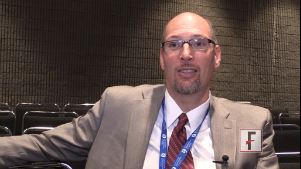User login
ATLANTA – Telepsychiatry “in some ways is a force multiplier” because it expands the flexibility of when, where, and how physicians can provide integrated care to more patients, Dr. James (Jay) H. Shore said at the annual meeting of the American Psychiatric Association. But psychiatrists thinking about setting up a telepsychiatry practice must learn about regulations, technology, and administrative processes, he added.
In this video, Dr. Shore describes the regulatory landscape that exists for telepsychiatrists, how telepsychiatry fits into a collaborative care model, and reimbursement issues. He also discusses which services telepsychiatrists are not yet paid for and the regulatory landscape. In addition, he mentions specific training resources available to clinicians interested in learning how to incorporate telepsychiatry into their practices.
Dr. Shore, associate professor of psychiatry at the University of Colorado at Denver, is chair of the American Psychiatric Association’s Committee on Telepsychiatry.
On Twitter @whitneymcknight
ATLANTA – Telepsychiatry “in some ways is a force multiplier” because it expands the flexibility of when, where, and how physicians can provide integrated care to more patients, Dr. James (Jay) H. Shore said at the annual meeting of the American Psychiatric Association. But psychiatrists thinking about setting up a telepsychiatry practice must learn about regulations, technology, and administrative processes, he added.
In this video, Dr. Shore describes the regulatory landscape that exists for telepsychiatrists, how telepsychiatry fits into a collaborative care model, and reimbursement issues. He also discusses which services telepsychiatrists are not yet paid for and the regulatory landscape. In addition, he mentions specific training resources available to clinicians interested in learning how to incorporate telepsychiatry into their practices.
Dr. Shore, associate professor of psychiatry at the University of Colorado at Denver, is chair of the American Psychiatric Association’s Committee on Telepsychiatry.
On Twitter @whitneymcknight
ATLANTA – Telepsychiatry “in some ways is a force multiplier” because it expands the flexibility of when, where, and how physicians can provide integrated care to more patients, Dr. James (Jay) H. Shore said at the annual meeting of the American Psychiatric Association. But psychiatrists thinking about setting up a telepsychiatry practice must learn about regulations, technology, and administrative processes, he added.
In this video, Dr. Shore describes the regulatory landscape that exists for telepsychiatrists, how telepsychiatry fits into a collaborative care model, and reimbursement issues. He also discusses which services telepsychiatrists are not yet paid for and the regulatory landscape. In addition, he mentions specific training resources available to clinicians interested in learning how to incorporate telepsychiatry into their practices.
Dr. Shore, associate professor of psychiatry at the University of Colorado at Denver, is chair of the American Psychiatric Association’s Committee on Telepsychiatry.
On Twitter @whitneymcknight
EXPERT ANALYSIS FROM THE APA ANNUAL MEETING
